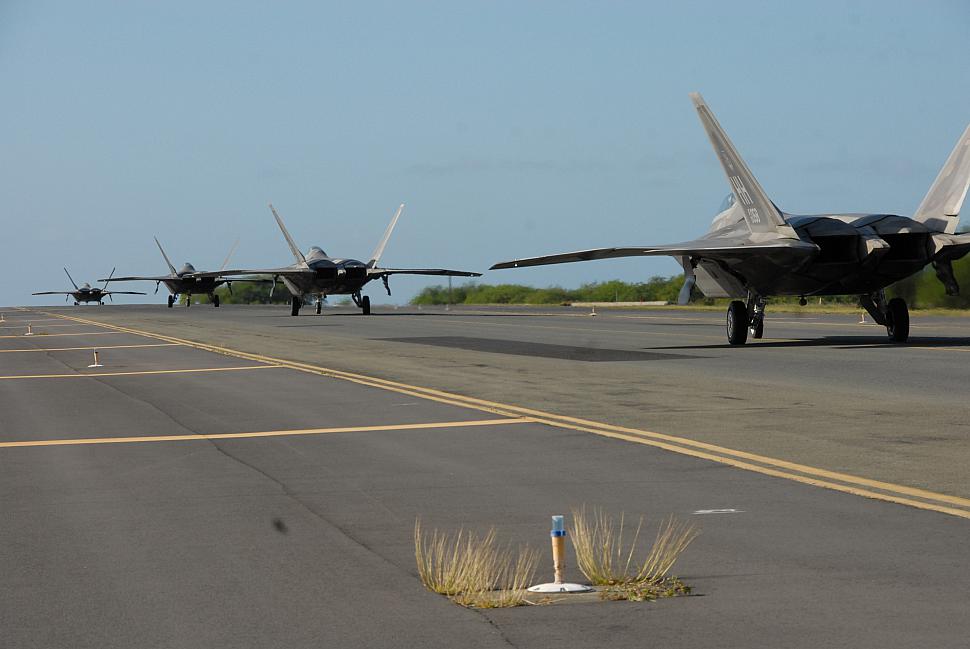Fighter Jet News
F-22 Raptor News
Hickam airmen exercise Rapid Raptor in Guam
December 3, 2014 (by
Bekah Clark) -
Airmen from the 15th and 154th Wings at Joint Base Pearl-Harbor Hickam, Hawaii, exercised the newest approach to fighter employment Nov. 20-24 at Andersen Air Force Base, Guam.

Rapid Raptor, which is still in the proof-of-concept phase, uses at least one C-17 to swiftly move, refuel and rearm a minimum of four F-22s in unfamiliar, austere environments.
"The ability to launch F-22s to a nontraditional location with a complement of additional pilots, embedded maintenance, as well as fuel and munitions, allows for unprecedented flexibility in 5th generation fighter aircraft deployment," said Lt. Col. David Eaglin, Pacific Air Forces' Chief of Current Operations and Power Projection Division.
These small detachments of U.S. fighters performing short-duration deployments will ultimately strengthen the overall U.S. posture with a smaller footprint than traditional expeditionary forces or theater security packages.
"This concept embodies the fundamental tenants of air power: speed, flexibility and surprise," said Eaglin. "Rapid Raptor, once operationalized, will enable us to deploy to and operate from austere locations with a contained cell of personnel and equipment. This will provide us a much greater capability to swiftly respond in support of security and stability in the region."
This iteration of the program - which was pre-planned and has been tested three times previously - was held in a simulated austere section of Andersen where personnel stayed in tent city.
This was also the first time that the 36th Contingency Response Group was embedded as a part of the detachment supporting Rapid Raptor.
The CRG, a rapid-deployment unit designed to be a "first-in" force to secure, establish and maintain an airfield and airfield operations, provided tents, water and air conditioning in addition to moving and inspecting the cargo.
"Our detachment operated independently from the rest of the base," said Capt. Mike Ball, the project officer for this iteration of the program. "But we were close enough to support agencies in the event we found a gap in our plan; which is what these proofs-of-concept are all about - finding the gaps in the plan and finding a way forward."
The detachment made strides in advancing the Rapid Raptor capability during its four days on the ground in addition to flying in support of Continuous Bomber Presence, Air Sea Battle and Jungle Shield missions.
"All in all this iteration of the Rapid Raptor concept development was a success," said Ball. "We're one step closer to increasing operational approaches available to ensure security and stability across the Asia-Pacific Region."
Four F-22 Raptors from the 19th and 199th FS taxi prior to take-off on November 20 at Joint Base Pearl Harbor-Hickam, Hawaii. The Raptors executed a Rapid Raptor deployment, which is still in the proof-of-concept phase, to Andersen, AFB, Guam Nov. 20-24. [Hawaii ANG photo by SrA Orlando Corpuz]
"The ability to launch F-22s to a nontraditional location with a complement of additional pilots, embedded maintenance, as well as fuel and munitions, allows for unprecedented flexibility in 5th generation fighter aircraft deployment," said Lt. Col. David Eaglin, Pacific Air Forces' Chief of Current Operations and Power Projection Division.
These small detachments of U.S. fighters performing short-duration deployments will ultimately strengthen the overall U.S. posture with a smaller footprint than traditional expeditionary forces or theater security packages.
"This concept embodies the fundamental tenants of air power: speed, flexibility and surprise," said Eaglin. "Rapid Raptor, once operationalized, will enable us to deploy to and operate from austere locations with a contained cell of personnel and equipment. This will provide us a much greater capability to swiftly respond in support of security and stability in the region."
This iteration of the program - which was pre-planned and has been tested three times previously - was held in a simulated austere section of Andersen where personnel stayed in tent city.
This was also the first time that the 36th Contingency Response Group was embedded as a part of the detachment supporting Rapid Raptor.
The CRG, a rapid-deployment unit designed to be a "first-in" force to secure, establish and maintain an airfield and airfield operations, provided tents, water and air conditioning in addition to moving and inspecting the cargo.
"Our detachment operated independently from the rest of the base," said Capt. Mike Ball, the project officer for this iteration of the program. "But we were close enough to support agencies in the event we found a gap in our plan; which is what these proofs-of-concept are all about - finding the gaps in the plan and finding a way forward."
The detachment made strides in advancing the Rapid Raptor capability during its four days on the ground in addition to flying in support of Continuous Bomber Presence, Air Sea Battle and Jungle Shield missions.
"All in all this iteration of the Rapid Raptor concept development was a success," said Ball. "We're one step closer to increasing operational approaches available to ensure security and stability across the Asia-Pacific Region."
Courtesy of Pacific Air Forces Public Affairs
Related articles:
Forum discussion:
Tags
- Hawaii ANG has full complement of F-22 Raptors ( 2012-09-20)
- Lockheed Martin support High-Tempo F-22 deployments worldwide ( 2011-03-17)
- Hickam's total force integration ( 2010-07-14)
- F-22 Raptor news archive
Forum discussion:
- Start a discussion about this article in the F-22 forum.
Tags
